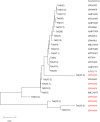Identification of Novel tet(X3) Variants Resistant To Tigecycline in Acinetobacter Species
- PMID: 36409072
- PMCID: PMC9784759
- DOI: 10.1128/spectrum.01333-22
Identification of Novel tet(X3) Variants Resistant To Tigecycline in Acinetobacter Species
Abstract
The emergence of the tet(X) gene is a severe challenge to global public health security, as clinical tigecycline resistance shows a rapidly rising trend. In this research, we identified two tigecycline-resistant Acinetobacter sp. strains containing seven novel tet(X3) variants recovered from fecal samples from Chinese farms. The seven Tet(X3) variants showed 15.4% to 99.7% amino acid identity with Tet(X3). By expressing tet(X3.7) and tet(X3.9), the tigecycline MIC values for Escherichia coli JM109 increased 64-fold (from 0.13 to 8 mg/L). However, the other tet(X3) variants did not have a significant change in the MIC of tigecycline. We found that the 26th amino acid site of Tet(X3.7) changed from proline to serine, and the 25th amino acid site of Tet(X3.9) changed from glycine to alanine, which reduced the MIC of tigecycline by 2-fold [the MIC of tet(X3) to tigecycline was 16 mg/L] but did not affect its expression to tigecycline. The tet(X3) variants surrounded by mobile genetic elements appeared in the structure of gene clusters with tandem repeat sequences and were adjacent to the site-specific recombinase-encoding gene xerD. Therefore, there is a risk of horizontal transfer of resistant genes. Our study reports seven novel tet(X3) variants; the continuing emergence of tigecycline variants makes continuous monitoring of resistance to tigecycline even more critical. IMPORTANCE Although it is illegal to use tigecycline and carbapenems to treat bacterial infections in animals, we can still isolate bacteria containing both mobile resistance genes from animals, and tet(X) is currently an essential factor in degrading tigecycline. Here, we characterized two multidrug-resistant Acinetobacter sp. strains that contained vital resistance genes, such as sul2, a blaOXA-164-like gene, floR, tetM, and multiple novel tet(X3) variants with different tandem structures. It is of paramount significance that their mechanism may transfer to other Gram-negative pathogens, even if their tandem structures have no cumulative effect on tigecycline resistance.
Keywords: Acinetobacter schindleri; Acinetobacter variabilis; tet(X); tet(X3); tigecycline resistance.
Conflict of interest statement
The authors declare no conflict of interest.
Figures






Similar articles
-
Earliest observation of the tetracycline destructase tet(X3).Microbiol Spectr. 2024 Apr 2;12(4):e0332723. doi: 10.1128/spectrum.03327-23. Epub 2024 Feb 27. Microbiol Spectr. 2024. PMID: 38412527 Free PMC article.
-
Emergence of novel tigecycline resistance gene tet(X5) variant in multidrug-resistant Acinetobacter indicus of swine farming environments.Vet Microbiol. 2023 Sep;284:109837. doi: 10.1016/j.vetmic.2023.109837. Epub 2023 Jul 27. Vet Microbiol. 2023. PMID: 37531842
-
Sporadic Dissemination of tet(X3) and tet(X6) Mediated by Highly Diverse Plasmidomes among Livestock-Associated Acinetobacter.Microbiol Spectr. 2021 Dec 22;9(3):e0114121. doi: 10.1128/Spectrum.01141-21. Epub 2021 Dec 1. Microbiol Spectr. 2021. PMID: 34851156 Free PMC article.
-
Genetic diversity and characteristics of high-level tigecycline resistance Tet(X) in Acinetobacter species.Genome Med. 2020 Dec 7;12(1):111. doi: 10.1186/s13073-020-00807-5. Genome Med. 2020. PMID: 33287863 Free PMC article.
-
Emerging High-Level Tigecycline Resistance: Novel Tetracycline Destructases Spread via the Mobile Tet(X).Bioessays. 2020 Aug;42(8):e2000014. doi: 10.1002/bies.202000014. Epub 2020 Jun 22. Bioessays. 2020. PMID: 32567703 Review.
Cited by
-
Exogenous adenosine counteracts tigecycline resistance in tet(X3)-harboring Escherichia coli.Microbiol Spectr. 2025 Aug 5;13(8):e0238224. doi: 10.1128/spectrum.02382-24. Epub 2025 Jul 7. Microbiol Spectr. 2025. PMID: 40622216 Free PMC article.
-
Epidemiology and antimicrobial resistance trends of Acinetobacter species in the United Arab Emirates: a retrospective analysis of 12 years of national AMR surveillance data.Front Public Health. 2024 Jan 4;11:1245131. doi: 10.3389/fpubh.2023.1245131. eCollection 2023. Front Public Health. 2024. PMID: 38239785 Free PMC article.
-
Occurrence and dissemination of antibiotic resistance genes in the Yellow River basin: focused on family farms.Environ Sci Pollut Res Int. 2024 Mar;31(11):16328-16341. doi: 10.1007/s11356-024-32290-5. Epub 2024 Feb 5. Environ Sci Pollut Res Int. 2024. PMID: 38316741
-
The tigecycline resistance mechanisms in Gram-negative bacilli.Front Cell Infect Microbiol. 2024 Nov 20;14:1471469. doi: 10.3389/fcimb.2024.1471469. eCollection 2024. Front Cell Infect Microbiol. 2024. PMID: 39635040 Free PMC article. Review.
-
Earliest observation of the tetracycline destructase tet(X3).Microbiol Spectr. 2024 Apr 2;12(4):e0332723. doi: 10.1128/spectrum.03327-23. Epub 2024 Feb 27. Microbiol Spectr. 2024. PMID: 38412527 Free PMC article.
References
-
- Cheng Y, Chen Y, Liu Y, Guo Y, Zhou Y, Xiao T, Zhang S, Xu H, Chen Y, Shan T, Xiao Y, Zhou K. 2020. Identification of novel tetracycline resistance gene tet(X14) and its co-occurrence with tet(X2) in a tigecycline-resistant and colistin-resistant Empedobacter stercoris. Emerg Microbes Infect 9:1843–1852. doi:10.1080/22221751.2020.1803769. - DOI - PMC - PubMed
-
- Yaghoubi S, Zekiy AO, Krutova M, Gholami M, Kouhsari E, Sholeh M, Ghafouri Z, Maleki F. 2022. Tigecycline antibacterial activity, clinical effectiveness, and mechanisms and epidemiology of resistance: narrative review. Eur J Clin Microbiol Infect Dis 41:1003–1022. doi:10.1007/s10096-020-04121-1. - DOI - PMC - PubMed
Publication types
MeSH terms
Substances
LinkOut - more resources
Full Text Sources
Medical
Molecular Biology Databases

